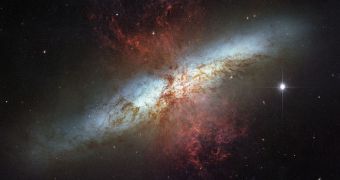Astronomers at the Harvard-Smithsonian Center for Astrophysics (CfA) recently led an international collaboration of researchers that analyzed the light released by a massive supernova blast. What is so intriguing about this particular object is that its host galaxy is 9.5 billion light-years away.
There are many reasons why this discovery is very important, one of them being that experts got the chance to study what they call an ultra-luminous core-collapse supernova, which is rather rare to see.
In addition, they now know that the light currently making its way to Earth showcases the distant galaxy and its exploded star as they appeared all those billion light-years ago. Right now, the entire galaxy may be the core of a supercluster, or may have long since died out, all of its stars burnt out.
Furthermore, light is a wonderful medium for storing data, and the photons released by the distant supernova are no different. Scientists say that they were able to discover that the gas present between the distant galaxy's stars was surprisingly normal.
What they mean by this is that hydrogen gas acted like it does now since very early on in the Universe. The finding lends additional credence of current astronomical models, which are based on a series of traits that never change, the properties of cosmic gas included.
CfA astronomer Edo Berger, the leader of the research group, says that the effect of the supernova was “like someone turned on a flashlight in a dark room and suddenly allowed us to see, for a short time, what this far-off galaxy looks like, what it is composed of.”
“This shows the enormous potential of using the most luminous supernovae to study the early Universe. Ultimately it will help us understand how galaxies like our Milky Way came to be,” he says.
Details of the new investigation were published in a recent issue of the esteemed Astrophysical Journal.
The Pan-STARRS1 survey telescope, on Haleakala in Maui, Hawaii, provided the dataset that ultimately revealed the existence of the distant supernova. The observatory is what astronomers describe as a pioneer of deep, wide-field, time-critical astronomy
“These are the types of exciting and unexpected applications that appear when a new capability comes on line,” says study co-author John Tonry, who holds an appointment as a supernovae researcher at the University of Hawaii in Manoa (UHM) Institute for Astronomy.

 14 DAY TRIAL //
14 DAY TRIAL //